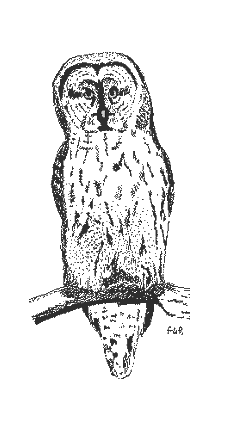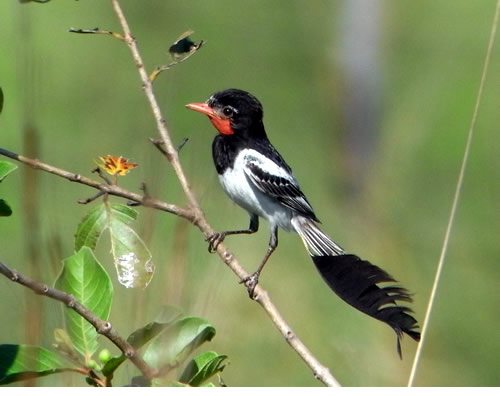Designed by Paul Smith 2006. This website is copyrighted by law.
Material contained herewith may not be used without the prior written permission of FAUNA Paraguay.
Photographs on this web-site were taken by Jonathan Newman and Paul Smith and are used with permission.
ARROYOS Y ESTEROS HALF-DAY TOUR
Introduction:
Arroyos y Esteros literally means "streams and marshes" and is an accurate description of the habitat that you will find here. A short drive from Asunción this is a great site for a much sought after and globally-threatened bird, the spectacular Strange-tailed Tyrant. Its not the only exciting bird you will see of course and an array of marshbirds like Long-tailed Reedfinch, Lesser Grassfinch, Crested Doradito, seedeaters and others will also be on your list. Combine it with half-day at the Bahía de Asunción (see below) for a full day of top notch birding.
Strange-tailed Tyrant male (right) Alectrurus risora
FAUNA Paraguay tours are recommended by:
FAUNA Paraguay eco-tours are promoted by:
|
|
|
|
 |
Birdfinders |
|
Main Targets:
Though our principal target on this half-day trip is the globally-threatened Strange-tailed Tyrant, our overall aim is to amass as big a list as possible in the allotted time.
Recommended duration:
This is a half-day tour only.
Best time to visit:
Arroyos y Esteros can be visited year round.
Itinerary:
Day 1 - Departure from hotel, bird-watching in Arroyos y Esteros and return to hotel.
(Itineraries are subject to change according to levels of animal activity or client´s preference.)
What else might we see?:
An extensive wetland with dense marshy areas and reedbeds, Arroyos y Esteros is a superb place for ticking off marsh inhabitants. Birds of course abound here, but keep your eyes open for snakes slithering through the water and of course the diversity of frog species which make up the majority of their diet. Serious listers will be here for the Strange-tailed Tyrant, and as a breeding site for the species this is one of the best places to see it. Males are decked out in black-and-white and the long, twisted tail is, well, strange to say the least. Another unusual feature of this frankly odd tyrant is that the feathers of the thtoat are lost during the breeding season, leaving it bare and red, only to grow back when reproduction is over.
Some of the more conspicuous birds we will see will be raptors, Savannah, Black-collared and Great Black Hawks for example, and the ubiquitous Snail Kite with its winkle-picker bill. Another species that specialises on water snails is the quite differently adapted Limpkin. In flooded areas Maguari Stork, White-faced and Bare-faced Ibis are possibilities, as is the bright pink Roseate Spoonbill. Herons are present in numbers, take your pick from any number of species, but the most frequent include Great, Snowy and Cattle Egrets, Cocoi, Whislting and Striated Heron. In the air above us Tawny-headed and White-rumped Swallow are likely to be present, as are Brown-chested Martin.
But the most interesting species are the ones that are not so obvious from a distance. We will be minutely surveying the grasslands and reedbeds for more secretive skulking species such as Crested Doradito, Lesser Grassfinch, Long-tailed Reedfinch and during October and November for migrant "cappuccino" seedeaters like Chestnut, Dark-throated, Marsh, Rufous-rumped and Tawny-bellied which often accompany flocks of the commoner Blue-black Grassquit and Double-collared Seedeater.
More associated with open marsh we will look for two wetland tyrant flycatchers, the White-headed Marsh-Tyrant and the Sooty Tyrannulet, as well as the commoner Fork-tailed Flycatcher and White Monjita. There is always the possibility of rails in the marsh vegetation too, we will be listening out for Ash-throated Crake and Rufous-sided Crake amongst others, whilst South American Snipe is frequently observed. Flocks of the charismatic and noisy Yellow-rumped Marshbird will be easy enough to locate and they are often in the presence of other Icterids such as Chopi Blackbird. Overhead wires should give photo opportunities for Ringed and Amazon Kingfishers.

What does it include?:
The price includes pick-up from and return to Asunción hotel, accommodation, transport, food, non-alcoholic drinks and guiding fees.
It does not include travel insurance, personal expenses, alcoholic drinks or travel costs incurred before the beginning of the tour or after return to Asunción.
Combine with an afternoon at the Bahia de Asuncion or Botanico for a full day birding:
For further information or to book your tour email us at faunaparaguay@yahoo.com.ar
Yellow-rumped Marshbird Pseudoleistes guirahuro




